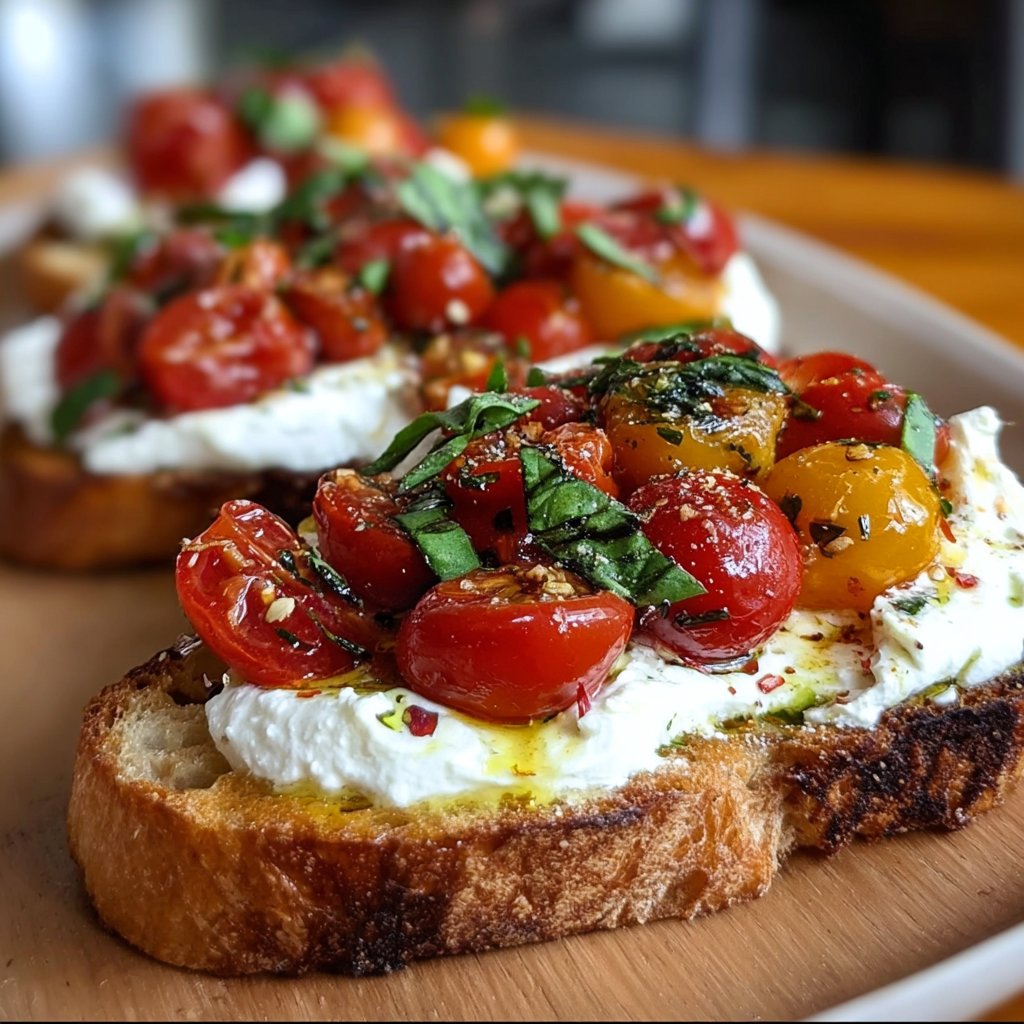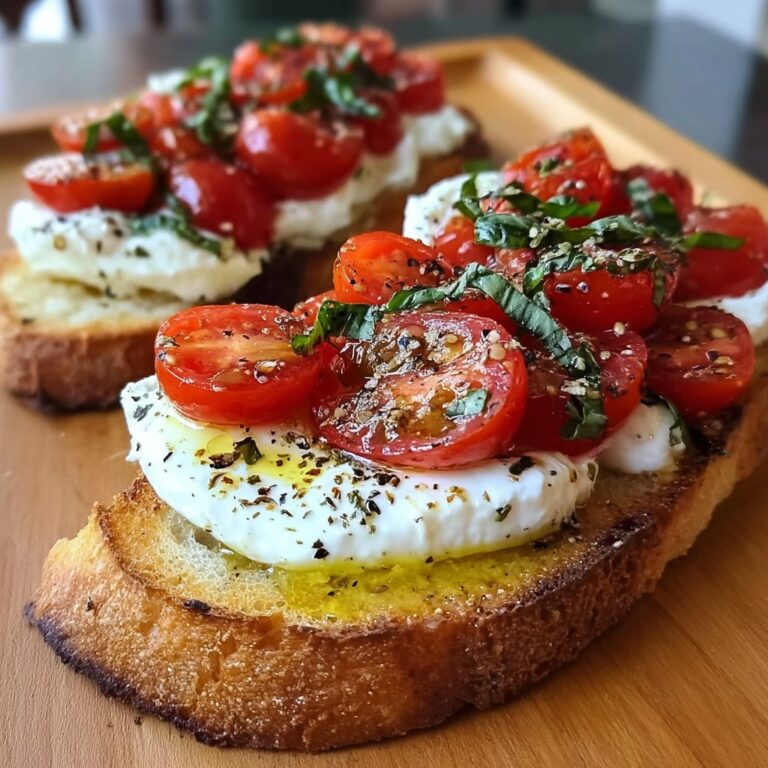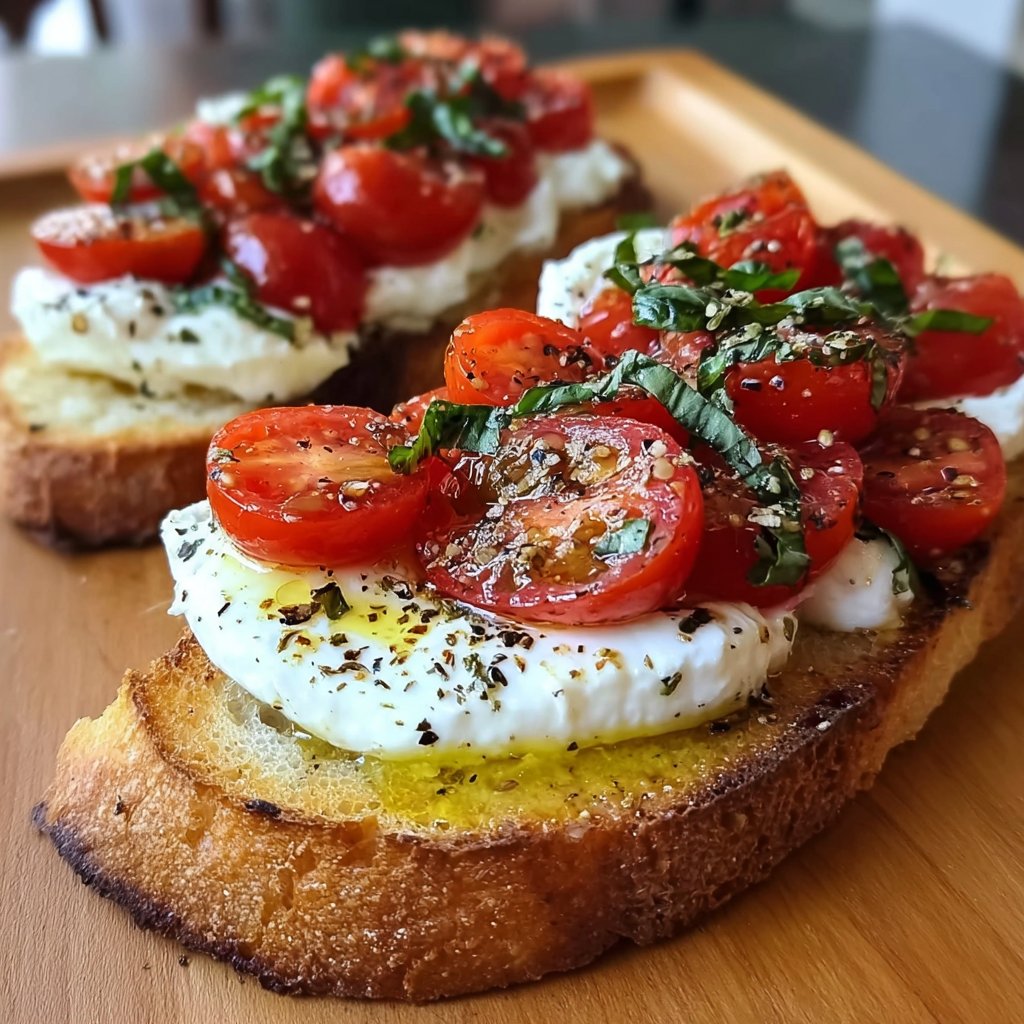Let Me Tell You Why Burrata Bruschetta Is My Weeknight Hero
You ever just stare at a ball of burrata in your fridge and think, “Ok, now what?” Yeah, me too. The first time I made this Burrata Bruschetta Tomato Basil thing, it was actually a total accident—I’d meant to make a Caprese but totally misjudged how much mozzarella I had (spoiler: none). So, burrata to the rescue! And honestly, now I make it when I want to look a little fancier for guests, but not like, Julia Child fancy. Plus, who doesn’t love when the cheese is so creamy it practically oozes? My cousin Jack once called it ‘cheese lava’—could be a band name, honestly.
Why You’ll Love This (Or, Why My Family Keeps Asking For It)
I whip this up when I’m too tired for real cooking but still want something that tastes like summer on toast. My family goes nuts for this because the bread’s crunchy, the tomatoes are juicy (if the dog hasn’t made off with one), and the burrata…well, let’s just say no one’s ever left a dollop behind. Sometimes I get frustrated chopping those tiny tomatoes—cherry tomatoes just roll everywhere like they’re auditioning for a circus—but it’s worth it. Oh, and if I’m feeling lazy I just tear the basil instead of slicing it, and no one’s ever called me out.
What You’ll Need (And What I Sometimes Swap In)
- Baguette – or honestly, any crusty bread. My grandmother swears by sourdough, but ciabatta works, too!
- Fresh burrata – about 200g. In a pinch, I’ve used mozzarella, but it’s not quite as dreamy.
- Cherry or grape tomatoes – 1 pint. Roma tomatoes are fine if you’re out of the tiny ones (I just chop them smaller).
- Fresh basil leaves – a good handful. Dried basil if you must, but really, try to get some fresh.
- Extra-virgin olive oil – a few glugs. I use this brand I found on Serious Eats, but use what you like.
- 1 clove garlic – for rubbing on the bread. Or skip if you’re not feeling garlicky.
- Salt & pepper – always to taste. My cousin piles on the pepper; I go easy.
- Balsamic glaze (optional) – I drizzle if I’m feeling extra, but sometimes I forget and it’s still great.
How I Actually Make It (With Occasional Chaos)
- Preheat your oven to 400F (200C). Or use a grill pan if it’s too hot for the oven. I’ve even used the toaster in desperate moments.
- Slice your baguette into, I dunno, 1/2-inch slices? Big enough to hold goodies, not so big you break your jaw. Lay them out on a baking sheet.
- Brush (or drizzle) both sides with olive oil. Don’t skimp, but don’t make them soggy either. This is where I sneak a taste of the oil, just because.
- Toast in the oven for 7–10 minutes, flipping halfway. Don’t panic if they’re a bit uneven; that’s called rustic.
- Meanwhile, halve your cherry tomatoes. If they’re stubborn, squish gently with your hand (over the sink, unless you want tomato confetti everywhere—ask me how I know).
- Chop or tear your basil. Bigger pieces mean more flavor explosions. Toss tomatoes, basil, a pinch of salt, and a glug of olive oil in a bowl. Maybe a grind or two of pepper. Sometimes I add a tiny splash of balsamic vinegar here, but not always.
- Once the toasts are out, rub the cut side of the garlic clove over the still-hot bread. But, if you forget, it’s not a dealbreaker.
- Now the fun bit: pile on the tomato mixture. Be generous but not so much that everything somersaults off the bread.
- Top each piece with a chunk of burrata (I just tear it with my hands, it’s messy but whatever).
- Drizzle with a little more olive oil, maybe a bit of balsamic glaze, and finish with another sprinkle of salt or basil if you’re fancy.
Random Notes (AKA, Stuff I’ve Learned the Hard Way)
- If your bread’s a bit stale, it actually toasts up better. Who knew?
- Don’t assemble too far ahead or the bread gets soggy—unless you like that, which is, y’know, valid.
- The tomatoes are best if they sit in the oil and salt for a few minutes, but I’ve rushed it and survived.
If You Want to Mix Things Up (Or, My Experiments)
- Try peaches instead of tomatoes in the summer. Sweet and creamy—pretty epic.
- Throw a handful of rocket (arugula for my American pals) on top. Adds a peppery bite.
- One time I tried roasted red peppers instead of tomatoes. Meh, didn’t hit the same notes.
- If you like heat, add a little chopped chili. (I don’t, but my neighbor swears by it.)
What If I Don’t Have Fancy Equipment?
Look, you don’t need a grill pan or even a baking sheet if you’re in a pinch—just toast the bread right in a skillet or even over a gas flame (carefully, please). I’ve even used my ancient sandwich press. Improvise! Actually, it’s half the fun.

How Long Does This Stuff Keep? (Real Talk)
Store any leftover tomato mixture in the fridge, separate from the bread. It’s probably fine for a day or so, but, honestly, in my house it never lasts the night. The bread goes stale if you pre-toast all of it, so just do what you’ll eat right away. Burrata itself is best fresh—if you have extra, try tossing it on pasta the next day (totally dreamy, btw).
How I Like To Serve It (And a Family Quirk)
I usually just pile everything on a big plate in the middle of the table and let everyone make their own. My brother eats his with his hands, but my mum insists on tiny plates and forks. It’s become a bit of a running joke. Once we had it as a starter before a big grilled fish dinner—very Mediterranean, very “holiday at home.” If you want to go all out, serve with a glass of crisp white wine—here’s a handy food pairing guide I like.
Pro Tips (Or, Stuff I Messed Up So You Don’t Have To)
- Don’t skip the salt on the tomatoes. I tried once, thinking the cheese would be salty enough, and nope—bland city.
- I once tried to assemble these ahead for a party, thinking I was being clever. The bread turned to mush. Lesson learned: assemble just before serving.
- Use the best olive oil you can swing, but don’t stress. I’ve used supermarket stuff and it was still lovely.
FAQ (You Actually Asked)
- Can I make this vegan? Honestly, you could try a vegan cheese, but the magic is in the burrata. Or just do tomato basil bruschetta—still ace.
- What’s the difference between burrata and mozzarella? Burrata’s kind of like mozzarella’s fancy, gooey cousin—it’s got that creamy center. (If you want to know more, here’s a good explanation.)
- Can I use dried basil? You can but…eh. It’s just not the same; I’d probably skip it rather than use dried, but up to you.
- Why does my burrata leak everywhere? That’s…what it does! Embrace the mess. It’s half the fun, honestly.
- Do I really need the garlic? Nope, but it makes the flavor pop. Sometimes I forget, and nobody riots.
So there you have it. Burrata Bruschetta Tomato Basil: not rocket science, but it feels a bit like edible sunshine—and if the bread’s a little burnt or the basil’s torn weird, trust me, no one’s gonna mind. Just enjoy it. And maybe hide an extra slice for yourself, because it does disappear fast.
Ingredients
- 1 loaf of rustic Italian bread (such as ciabatta or baguette), sliced
- 2 tablespoons extra-virgin olive oil
- 2 cups cherry tomatoes, halved
- 1 clove garlic, peeled
- 1 ball (about 200g) fresh burrata cheese
- 1/4 cup fresh basil leaves, torn
- Salt and freshly ground black pepper, to taste
- Balsamic glaze, for drizzling (optional)
Instructions
-
1Preheat the oven to 400°F (200°C). Arrange the bread slices on a baking sheet and brush both sides lightly with olive oil.
-
2Toast the bread in the oven for 8-10 minutes, turning once, until golden and crisp. Remove from the oven and rub one side of each slice with the garlic clove.
-
3In a bowl, toss the cherry tomatoes with a pinch of salt and pepper. Let them sit for a few minutes to release their juices.
-
4Arrange the toasted bread slices on a serving platter. Top each slice with a generous spoonful of tomatoes.
-
5Tear the burrata cheese and distribute it evenly over the tomatoes. Scatter fresh basil leaves on top.
-
6Drizzle with a little more olive oil and balsamic glaze if desired. Serve immediately.
Approximate Information for One Serving
Nutrition Disclaimers
Number of total servings shown is approximate. Actual number of servings will depend on your preferred portion sizes.
Nutritional values shown are general guidelines and reflect information for 1 serving using the ingredients listed, not including any optional ingredients. Actual macros may vary slightly depending on specific brands and types of ingredients used.
To determine the weight of one serving, prepare the recipe as instructed. Weigh the finished recipe, then divide the weight of the finished recipe (not including the weight of the container the food is in) by the desired number of servings. Result will be the weight of one serving.
Did you make this recipe?
Please consider Pinning it!!






